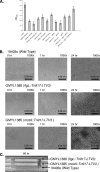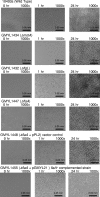Loss of flagellum-based motility by Listeria monocytogenes results in formation of hyperbiofilms
- PMID: 18586947
- PMCID: PMC2519545
- DOI: 10.1128/JB.00155-08
Loss of flagellum-based motility by Listeria monocytogenes results in formation of hyperbiofilms
Abstract
Biofilm formation by the gram-positive, motile, food-borne pathogen Listeria monocytogenes was demonstrated to occur by an ordered series of stages. Biofilm development involves flagellum-based motility, which when blocked decreases initial bacterial surface attachment but subsequently leads to the formation of hyperbiofilms, surface-attached communities reaching high density.
Figures




Similar articles
-
Flagellar motility is critical for Listeria monocytogenes biofilm formation.J Bacteriol. 2007 Jun;189(12):4418-24. doi: 10.1128/JB.01967-06. Epub 2007 Apr 6. J Bacteriol. 2007. PMID: 17416647 Free PMC article.
-
Listeria monocytogenes flagella are used for motility, not as adhesins, to increase host cell invasion.Infect Immun. 2006 Dec;74(12):6675-81. doi: 10.1128/IAI.00886-06. Epub 2006 Sep 18. Infect Immun. 2006. PMID: 16982842 Free PMC article.
-
Molecular biology of surface colonization by Listeria monocytogenes: an additional facet of an opportunistic Gram-positive foodborne pathogen.Environ Microbiol. 2011 Apr;13(4):835-50. doi: 10.1111/j.1462-2920.2010.02378.x. Epub 2010 Nov 18. Environ Microbiol. 2011. PMID: 21087384 Review.
-
Effect of flagella on initial attachment of Listeria monocytogenes to stainless steel.Appl Environ Microbiol. 2000 Feb;66(2):860-3. doi: 10.1128/AEM.66.2.860-863.2000. Appl Environ Microbiol. 2000. PMID: 10653766 Free PMC article.
-
Current knowledge and perspectives on biofilm formation: the case of Listeria monocytogenes.Appl Microbiol Biotechnol. 2013 Feb;97(3):957-68. doi: 10.1007/s00253-012-4611-1. Epub 2012 Dec 12. Appl Microbiol Biotechnol. 2013. PMID: 23233205 Review.
Cited by
-
Role of extracellular DNA during biofilm formation by Listeria monocytogenes.Appl Environ Microbiol. 2010 Apr;76(7):2271-9. doi: 10.1128/AEM.02361-09. Epub 2010 Feb 5. Appl Environ Microbiol. 2010. PMID: 20139319 Free PMC article.
-
Listeria monocytogenes Biofilm Adaptation to Different Temperatures Seen Through Shotgun Proteomics.Front Nutr. 2019 Jun 14;6:89. doi: 10.3389/fnut.2019.00089. eCollection 2019. Front Nutr. 2019. PMID: 31259174 Free PMC article.
-
Arcobacter butzleri Biofilms: Insights into the Genes Beneath Their Formation.Microorganisms. 2022 Jun 23;10(7):1280. doi: 10.3390/microorganisms10071280. Microorganisms. 2022. PMID: 35888999 Free PMC article.
-
Counterclockwise rotation of the flagellum promotes biofilm initiation in Helicobacter pylori.mBio. 2024 Jun 12;15(6):e0044024. doi: 10.1128/mbio.00440-24. Epub 2024 May 3. mBio. 2024. PMID: 38700325 Free PMC article.
-
Listeria monocytogenes Biofilms in Food-Associated Environments: A Persistent Enigma.Foods. 2023 Sep 6;12(18):3339. doi: 10.3390/foods12183339. Foods. 2023. PMID: 37761048 Free PMC article. Review.
References
-
- Chae, M. S. 2001. Cell viability of Listeria monocytogenes biofilms. Food Microbiol. 18103-112.
-
- Chae, M. S., and H. Schraft. 2000. Comparative evaluation of adhesion and biofilm formation of different Listeria monocytogenes strains. Int. J. Food Microbiol. 62103-111. - PubMed
Publication types
MeSH terms
Substances
LinkOut - more resources
Full Text Sources

